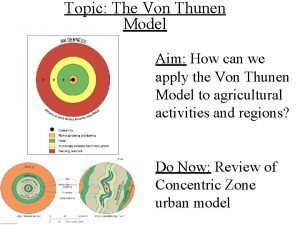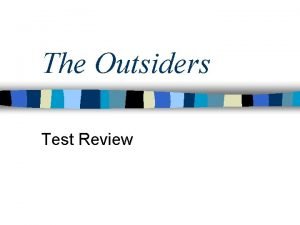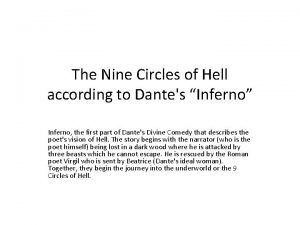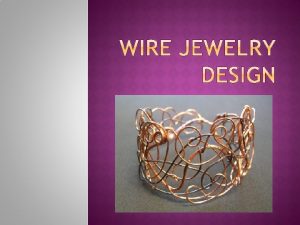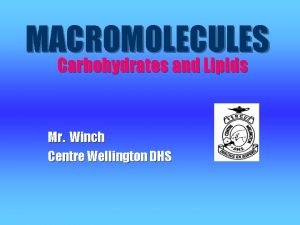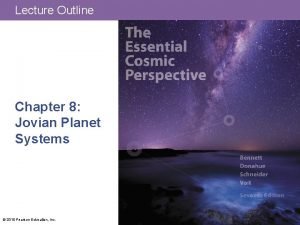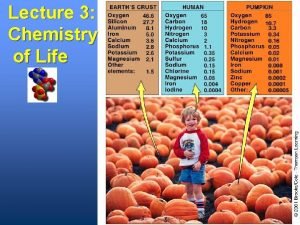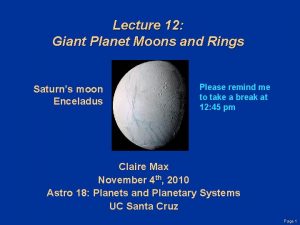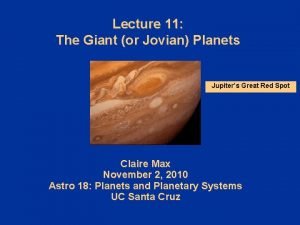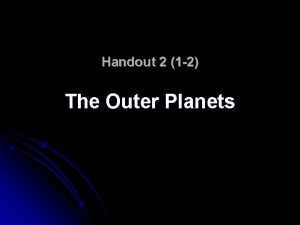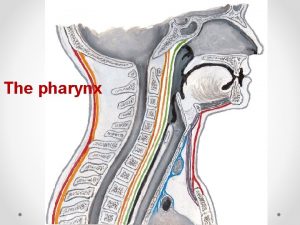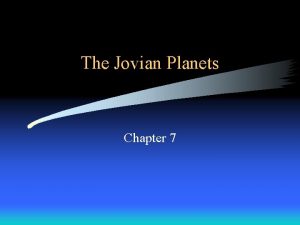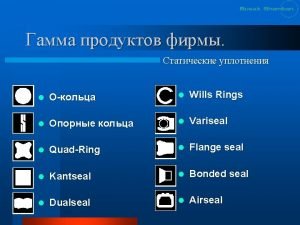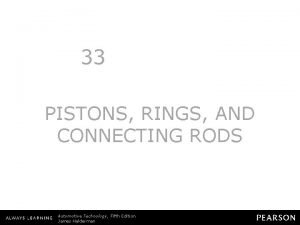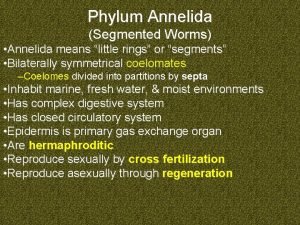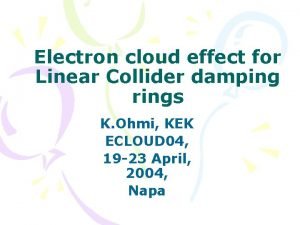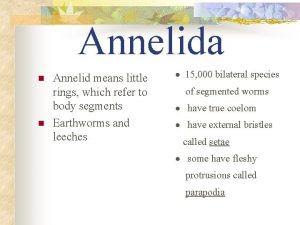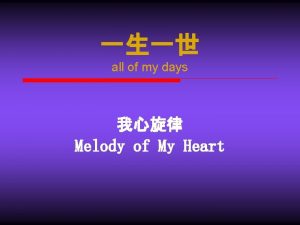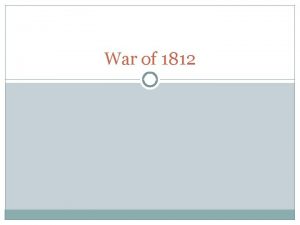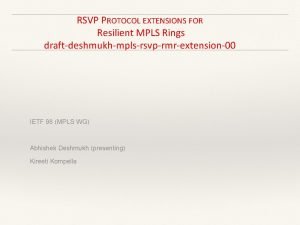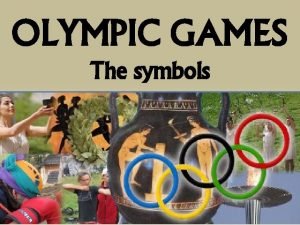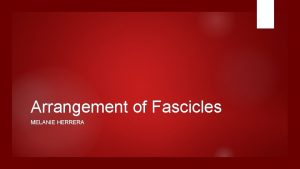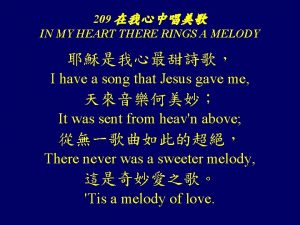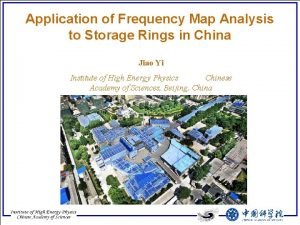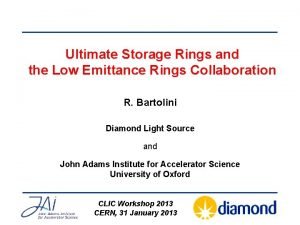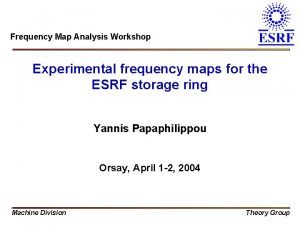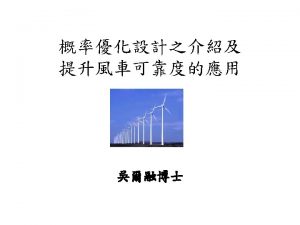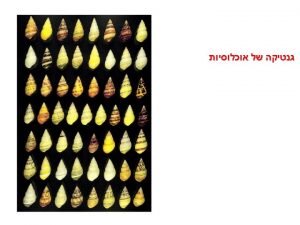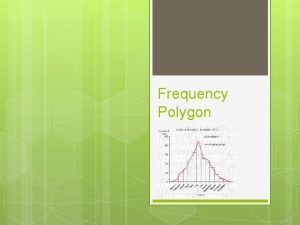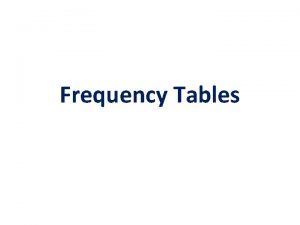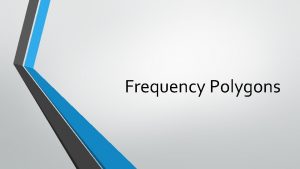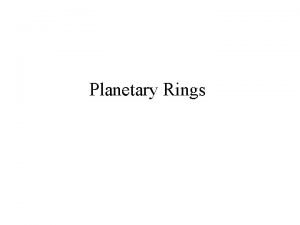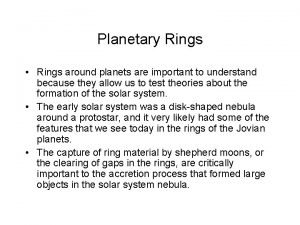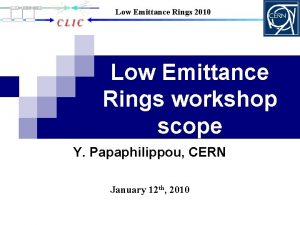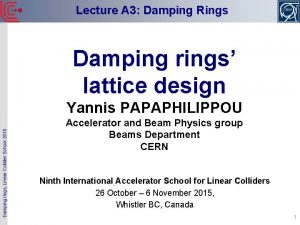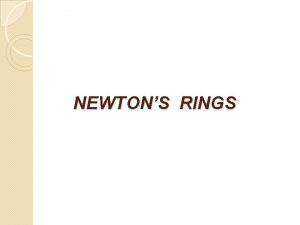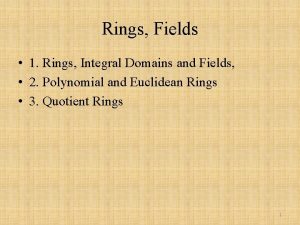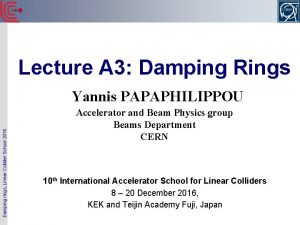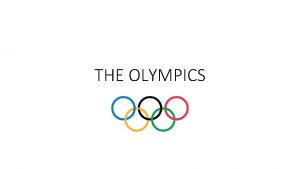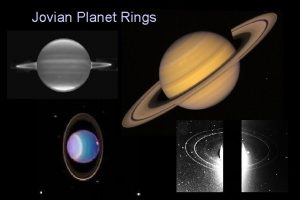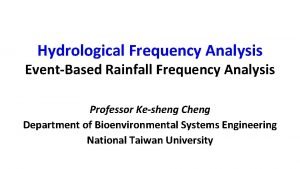Application of Frequency Map Analysis to Storage Rings



















































- Slides: 51

Application of Frequency Map Analysis to Storage Rings in China Jiao Yi Institute of High Energy Physics Chinese Academy of Sciences, Beijing, China

Outline ü Shanghai Synchrotron Radiation Facility (SSRF) Super-periodic structural resonance (SSR) ü Beijing Electron Positron Collider Upgrade Project (BEPCII) Synchro-betatron resonance ü Beijing Advanced Photon Source (BAPS) Multi-objective genetic algorithms (MOGA) method

Frequency map analysis (FMA) Frequency map: SOLEIL, France SSRF, China Courtesy of L. Nadolski, SOLEIL 1/42

SSRF: A third generation light source Main parameters of SSRF storage ring Beam energy Circumference Ge. V 3. 5 m 432 Super-period No. Natural horizontal emittance x 0 4 nm rad Number of cells Straight sections: length number Twiss parameters in one super-period 3. 90(7. 98*) 20 m 12. 0 4 6. 5 16 Betatron tunes Qx/Qy 22. 22/11. 32 Natural chromaticities x/ y -54. 3/-18. 3 Dominative resonance: 3 Qx-2 Qy = 44 2/42

Motion near the resonance 3 Qx-2 Qy=44 It is a Super-periodic Structural Resonance (SSR). For particle with different coordinates Tracking with AT. Tune vs. horizontal amplitude 3/42

Linear super-periodic structural resonances-I Linear magnetic field errors lead to first or second order super-periodic structural resonances. If Q is closed to stop band, the off momentum particle dynamics optimization will be difficult. Stopbands: Q = M N /2, M is the super-period No. v=Kd / kd 0 Qx=22 Qx=23 Qx=24 Qy=12 Qy=11 Qy=10 Blue: horizontal Red: Vertical u=Kf / kf 0 Necktie diagram for SSRF Black star: nominal working point (22. 22, 11. 32) DK source: off-momentum particles (1+d) p 0 4/42

Linear super-periodic structural resonances-II For modern acclerators with complex lattice structure, necktie diagram still works well. Some integer or half integer resonance exhibits as “stopband” in Kf - Kd space, implying stronger effect than others. “…The formation of the structural resonance stopband comes from the harmonic number of the super-periodic resonance in the lattice configuration. …” Courtesy of S. X. Fang and Q. Qin, HEP & NP 30(9) 880 The first and second order super-periodic structural resonance (SSR) is M is super-period number of the lattice. The resonance is first order when l is even and second order when l is odd. How about higher order resonances with the same harmonics as the linear SSR? For SSRF, the resonance 3 Qx-2 Qy = 44 has the same harmonic with the 2 Qx = 44 second order SSR stop band How about nonlinear magnetic fields (sextupoles, most strong nonlinear components in light source)? 5/42

Linear SSR by sextupoles Ideal SSRF lattice, with sextupoles as the only one nonlinear source. (22. 04, 11. 24) (23. 04, 11. 24) Qx =22 is second order SSR, Qx =23 is not linear SSR. 6/42

Sextupoles & SSR 11. 36 Coutesy of S. Q. Tian, SSRF B A C A, B (~0. 1): 2 Qx = 44 C(~0. 04) : 3 Qx - 2 Qy = 44 On-momentum DA vs. Qx 7/42 off-momentum DA vs. Qx

Higher order SSR vs. Working point Five work points, (22. 12, 11. 17), (22. 16, 11. 23), (22. 22, 11. 32), (22. 26, 11. 38) and (22. 32, 11. 47) along the resonance 3 Qx- 2 Qy = 44. 8/42

Higher order SSR vs. Working point (cont. ) Identify resonance with FMA 1, Average diffusion rate (resonance strength) 2, Resonance location in (x, y) space 3, Resonance-trapped particle NO. W. P. Resonance location Trapped particles NO. (%) Average diffusion rate <D> On x axis (y = 0 mm) On the line x = 20 mm (22. 12, 11. 17) (7. 3, 0. 0) (20, 12. 3) 1. 51 -3. 48 (22. 16, 11. 23)A (9. 5, 0. 0) (20, 13. 7) 14. 43 -4. 70 (22. 16, 11. 23)B (10. 2, 0. 0) (20, 12. 3) 1. 79 -3. 54 (22. 22, 11. 32) (9. 1, 0. 0) (20, 13) 1. 64 -3. 76 (22. 26, 11. 38) (10. 5, 0. 0) (20, 10. 2) 1. 04 -3. 53 Pruple-(22. 12, 11. 17) black-(22. 16, 11. 23)A Yellow-(22. 16, 11. 23)B Red -(22. 22, 11. 32) Green- (22. 26, 11. 38) Blue- (22. 32, 11. 44) Lie Method calculation (Lie. Math) for contrast 1, Resonance amplitude term 2, Resonance location 9/42

Higher order SSR vs. Working point (cont. ) Resonance location comparison W. P. further away from the SSR stopband 2 Qx = 44, Resonance strength becomes weaker ((22. 16, 11. 23)A is an exception, with low tune diffusion while much more particles are trapped into the resonance). Resonance strength comparison W. P. further away from the SSR stopband 2 Qx = 44, Resonance affects the particle with larger initial amplitudes. 10/42

Higher order SSR & tune optimization If the lattice is M periodic, i. e. , composed of M identical sectors (this is the case for a perfect machine), the first and second order SSR is The resonance is first order when l is even and second order when l is odd. If the working point near the first or second order SSR stopband the nearby structural resonance satisfies Namely, the harmonic number of the resonance is the multiple of both M and RQ, the resonance will be HOSSR. SSR diagram near the SSRF W. P. SSR is structural resonance with specific harmonic number, even with high order, it can have relatively large effects on beam dynamics. Y. Jiao, S. X. Fang, “High Order Super-periodic Structural resonance”, EPAC 08 11/42

Application of higher order SSR, SOLEIL e d f c Super-period No. = 4 SSR stopband nearby W. P. : b Qy = 8, 2 Qx = 36 a HOSSR nearby W. P. : a. 7 Qx =16 8; b. 5 Qx + 2 Qy = 3× 36; c. 3 Qx + 4 Qy=11× 8; d. 3 Qx + 3 Qy=10× 8; Qx + 6 Qy=4× 8; f. 4 Qx - 3 Qy=6× 8 e. - SSR diagram nearby the W. P. Frequency maps in the following slides, mostly come from paper: L. Nadolski and J. Laskar, Review of single particle dynamics for third generation light sources through frequency map analysis, Phys. Rev. ST AB 6, 114801 (2003) 12/42

Application of higher order SSR, SOLEIL (cont. ) Modify the sextupoles strength to fold the frequency map thus avoid 5 Qx + 2 Qy = 3× 36。 The 7 th-order coupling resoance, 5 vx + 2 vy - 4× 27=0, reached for the horizontal amplitude x =24 mm. Courtesy of L. Nadolski, SOLEIL 13/42

Application of higher order SSR, SOLEIL (cont. ) New W. P. (18. 30, 8. 38) Move W. P. right to avoid 7 Qx = 16× 8。 …the new working pint is (v x, vy) = (18. 30, 8. 38), in order that the horizontal tune never cross the 7 th-order resonance 7 vx - 4× 32=0… 14/42 Courtesy of L. Nadolski, SOLEIL

Application of higher order SSR, ESRF Super-period No. =16,W. P. = (36. 44,14. 39), far away from first or second order SSR stopband. On-momentum particle can cross the integer resonance Qx = 36 without loss. Courtesy of L. Nadolski, SOLEIL 15/42

Application of higher order SSR, ALS Circumference = 196 m,super-period No. = 12,W. P. = (14. 25,8. 18), far away from SSRs. On-momentum particle can cross the integer resonance Qy = 8 without loss. Courtesy of L. Nadolski, SOLEIL 16/42

Application of higher order SSR, Super-ACO Circumference = 72 m,super-period NO. =4,W. P. =(4. 72,1. 70), close to SSR stopband The dominative resonance Qx + 2 Qy = 4× 2 is a third order HOSSR. …Globally the beam dynamics is mainly dominated by this coupoled resonance vx + 2 vy -2× 4=0. In its vicinity, a particle repidly escapes to unbonded motions… 17/42 Courtesy of L. Nadolski, SOLEIL

BEPCII: a high luminosity double-ring collider e+ e 18/42

BEPCII high luminosity mode lattice Qx near 0. 5 provides the highest luminosity Coutesy of Dr. Y. Zhang Parameter Unit Collision mode Beam energy Ge. V 1. 89 Circumference m 237. 53 RF voltage MV 1. 5 Qx/Qy/Qs 6. 51/5. 58/ 0. 034 -10. 7/-21. 0 Natural chromatity Horizontal natural emittance nm rad 141 bx / by (IP) m 1 / 0. 015 Twiss functions and main parameters along the ring 19/42

FMA on the high luminosity mode RF and radiation are turned on while tracking. Dp / p=0 Dp / p= -0. 6% Dp / p= 0. 6% On- and offmomentum DAs 20/42

FMA on the high luminosity mode (cont. ) The off-momentum FMs are not folded as the onmomentum case and the tune footprints cover the range Qx (6. 514, 6. 516) with a high diffusion rate or even particle loss. Synchro-betatron resonance: 2 Qx - Qs = 13 Offmomentum FM 1, Reduce the anharmonic terms (d. Qx/dx 2, d. Qx/dy 2, d. Qy/dy 2) from (73, 77, 208) to (70, 68, 198). 2, Reduce the effect of the synchro-betatron resonance On-momentum FM The growth time of the resonance 2 Qx - Qs = 13 is: H along the whole ring is calculated and minimized by fine-tuning all the sextupole strengths. For example, we reduce the H from 19. 7 to 3. 1 for d = 0. 3%. The FMs with Dp /p =0, ± 0. 6% together 21/42

Optimizing the high luminosity mode before optimization The increase of size of DA with errors tracking with SAD Re du ce an ha rm o nic i ty Minimize the growth time of resonance Solid line square: collision DA requirement Dashed line square: injection DA requirement 22/42

Resonance confirmed in commissioning Luminosity scan in tune space, 8 th May, 2009. Qy Electron ring Qy Positron ring Qx Qx Luminosity falls down in tune range Qx (6. 515, 6. 520) Beam lost when Qx is nearby 6. 515 23/42

Beijing Advanced Photon Source (BAPS) A third generation light source, Energy: 5 Gev, Circumference: ~1200 m, Low emittance: ~1 nm PEP-X BAPS PEP-X 24/42

Beijing Advanced Photon Source (BAPS) Parameters Unit Value Energy E Ge. V 5 Circumference C m 1218. 4 Revolution time μs 4. 06 Number of cells 50 Standard structure DBA Super-period number 5 Straight sections: length*number m Beta functions in the middle of straight sections bx/by/Dx Emittance ex/ey (with wiggler) Twiss functions through one super-period of Storage ring 16. 5/3. 8/0 1. 88/1. 63/0 nm. rad Phase advance per cell: (1. 307, 0. 588) Natural chromaticity per cell: (-5. 54, -1. 31) 25/42 1. 12/0. 01 (0. 5/0. 005) Natural energy spread 0. 094% Momentum compaction 0. 00007 RF voltage MV 6 RF frequency MHz 499. 982 Harmonic number W. P. : (64. 28, 29. 20) 5 14. 6 45 6. 4 2032 Bunch length ps/mm 8. 7/2. 6 Damping time tx/ty/tz ms 15. 2/7. 6 Beam current m. A 200~300

BAPS sextupoles arrangement Two groups of chromaticity correction sextupoles (SD/SF) Seven groups of harmonic correction sextupoles (SYF/SZF/SWD/SZD/SXF/SYD) SYF SZF SWD SZD SD SD SF 26/42 SXD SYD SXF

BAPS—Dynamics with no harmonic sextupoles Large DQ/Dp/p 0 ~0. 5 Large DQ/Jx, y Small DA for all Dp/p 0 W. P. 64. 28, 29. 20 27/42

BAPS—OPA optimization OPA code based on Hamilton resonance theroy DA still small DQx nonlinear increase with Jx DQx with Dp/p still large W. P. 64. 35, 29. 20 28/42

BAPS—MOGA optimization Multi-objective genetic algorithms Seven Variables: harmonic sextupole strength Aim value: larger DA size and smaller tune variation over dp/p~(-0. 03, 0. 03) Initial random seeds (10 4) Calculate aim value Choose the best ones Selection, crossing, mutation New random seeds New generation The final best result(s) W. P. 64. 28, 29. 20 D. Robin et al, PRSTAB, 11, 024002 (2008) 29/42

BAPS—three approaches comparison No harmonic sextupoles With OPA code With MOGA DQ vs DP DQx max 0. 56 0. 25 0. 23 (-0. 03~0. 03) DQy max 0. 10 0. 03 0. 012 DA for X max 1. 8 mm 5 mm 10. 5 mm Dp/p = 0 Y max 3. 2 mm 4 mm 7. 5 mm DA for Dp/p = -3% X max 2 mm 3. 8 mm 6. 5 mm Y max 2. 4 mm 3 mm 6. 2 mm DA for Dp/p = +3% X max 2. 4 mm 7 mm 10 mm Y max 3. 1 mm 6 mm 9 mm Can we find a lattice with small emittance and relatively small natural chromaticity at the same time? How can we make sure the lattice we find is the best one? 30/42

BAPS—linear optics scanning with MOGA D 1 D 2 D 3 D 4 D 5 D 6 D 5 D 4 D 3 QM 4 QM 5 QM 4 QM 1 QM 2 QM 3 B D 2 D 1 QM 3 QM 2 QM 1 B D 0 +DM(3. 2 m)+D 0 Twelve Variables: Attention: Drift lengths, quadrupole gradients Phase advance per cell Natural chromaticity per cell Limitions: Circumference Structure: 48 standard DBA cells Emittance Straight section length: not small than 6. 4 m Twiss function at the middle of the straight section and the entrance of the dipole Circumference: not larger than 1180 m 3. 2 m>bx/by at the center of the straight section>1. 5 m 31/42

Stable solution-generation I 32/42

Stable solution-generation II 33/42

Stable solution-generation III 34/42

Stable solution-generation IV Most stable solutions exist in range of Qx~ (0, 1. 5) per cell. With the Qx per cell changes from 0 to 1. 5, the available low emittance decreases, and the available small natural chromaticity increases, as we expected. 35/42

Stable solution-detail information Emittance 1. 0 nm, Qx, min ~0. 9, xx ~ (0. 7, 2. 0) per cell 36/42

Stable solutions fulfilling achromatic conditions Achromatic conditions: Dx=Dx’=0 at the entrance of dipole (numerically smaller than 0. 01) Solutions fulfilling achomatic condition exist only in Qx ~(0. 9, 1. 5) 37/42

Stable solutions fulfilling achromatic conditions II When achromatic conditions are satisfied for DBA cells, Dx, |Dx’|<0. 01 Dx, |Dx’|<10 -4 For e=1. 2, MOGA vs. theoretical calculation 41/42 L: dipole length; r: bending radius; a 0, b 0: beta functions at the entrance of the dipole; g: energy factor; Cq=3. 8319× 1013 m

Stable solutions fulfilling achromatic conditions III If e<2 nm, Qx>1. 2, xx>2. 65 per cell Dx=Dx’=0 at the entrance of dipole (numerically smaller than 10 -4) 38/42

Stable solutions fulfilling achromatic conditions IV 2 nm is a turning point. Above 2 nm, emittance changes a lot, the corresponding available small chromaticity changes a little. Below 2 nm, with emttiance decreases a little, the corresponding available small chromaticity increases very quickly. Dx=Dx’=0 at the entrance of dipole smaller than 10 -4。 Emittance vs. xx per cell 39/42

Stable solutions fulfilling achromatic conditions V With 48 achromatic DBA cells, it is hard to reach 1 nm with natural chromaticity smaller than 5. 5. To reach e~1. 3 nm, the available small xx is about 4. 5, the available small circumference is about 1120 m. Emittance vs. circumference for specific xx 40/42

Stable solutions fulfilling achromatic conditions VI Lattice based on MOGA linear optics scanning Super-period No. is 4. The circumference is 1186. 7 m. The tune per cell is (1. 326, 0. 628). The natural chromaticity per cell is (-4. 5, -1. 63); The emittance is 1. 33 nm. Half matching + half standard cell 42/42

Summary ü Frequency map analysis is very helpful in nonlinear optimization. ü Super-periodic structural resonances have non-negligible effects on beam dynamics for the third generation light sources. ü Synchro-betatron resonance is an important source of dynamic aperture limitation for the BEPCII colliding mode lattice. ü FMA together with MOGA show large potential in design and optimization of light source nowadays.


Additional slides

First and second order SSR mechanism Tune is closed to stopband Beta function variation rate will be large Particles with different momentum will “experience” different optics, the natural chromaticity will be different too If too closed to the stopband, the particle amplitude will increase quickly, finally lost Chromaticity correction Effective range will be small, for a little dp/p, tune may change a lot, cause asymmetry of dynamic aperture (DA)for different dp/p. The nonlinear correction effective range may be small, thus possibly bad results for nonzero momentum DA。

Experimental evidence for SSRs ? Two best experimental machines: SSRF, does not start FMA experiments till now SOLEIL, design changed. W. P. from (18. 28, 8. 38) to (18. 2, 10. 3) The W. P. just locates on the SSR resonance SSR diagram nearby the SOLEIL W. P.

Experimental evidence for SSRs ? The SSR resonance’s effect is obvious, but the resonance is not very strong. W. P. :(18. 2,10. 3) (18. 2,10. 305)

Experimental evidence for SSRs ? However, the W. P. is moved again to (18. 202, 10. 317) due to optimization of the injection efficiency. The tune footprints for on-momentum case of bare lattice cover small area in tune space, do not cross the resonance. The experiment results do not accord well with the model. DO NOT HAVE STRONG EXPERIMENTAL EVIDENCE TILL NOW! HOSSR Qx + 6 Qy = 80 Courtesy of Nadji, SOLEIL
 Row conditional relative frequency
Row conditional relative frequency How to calculate relative frequency
How to calculate relative frequency Form factor formula
Form factor formula Vmax=aw
Vmax=aw Frequency vs relative frequency
Frequency vs relative frequency Joint frequency vs marginal frequency
Joint frequency vs marginal frequency Marginal frequency distribution
Marginal frequency distribution Primary storage and secondary storage
Primary storage and secondary storage Secondary storage vs primary storage
Secondary storage vs primary storage Secondary storage provides temporary or volatile storage
Secondary storage provides temporary or volatile storage Unified storage vs traditional storage
Unified storage vs traditional storage Joslin class rings
Joslin class rings What two things do tree rings indicate
What two things do tree rings indicate Von thunen model rings explained
Von thunen model rings explained Voice box in the respiratory system
Voice box in the respiratory system Marica the outsiders
Marica the outsiders Dante circles of hell
Dante circles of hell Personal ornaments such as necklaces, rings, or bracelets.
Personal ornaments such as necklaces, rings, or bracelets. Slogan about media codes and conventions
Slogan about media codes and conventions Sharroky hollie rings of culture
Sharroky hollie rings of culture Lipids made up of rigid carbon rings
Lipids made up of rigid carbon rings Why do jovian planets have rings
Why do jovian planets have rings Lipids made up of rigid carbon rings
Lipids made up of rigid carbon rings Why do jovian planets have rings
Why do jovian planets have rings Jupiter magnetosphere
Jupiter magnetosphere How are terrestrial planets different from jovian planets?
How are terrestrial planets different from jovian planets? Comfort devices introduction
Comfort devices introduction Matching planet rings
Matching planet rings Written codes
Written codes What are the three rings of responsibility on social media
What are the three rings of responsibility on social media Lipids made up of rigid carbon rings
Lipids made up of rigid carbon rings Passive voice
Passive voice A shot rings throughout europe
A shot rings throughout europe Waldeyer's rings
Waldeyer's rings Jupter facts
Jupter facts Wills rings
Wills rings This phylum name means “little rings”
This phylum name means “little rings” Pistons rings and connecting rods
Pistons rings and connecting rods What phylum means little rings
What phylum means little rings Electron cloud rings
Electron cloud rings Means little rings
Means little rings Wordle 27/1
Wordle 27/1 Why does saturn have rings
Why does saturn have rings Planet.click
Planet.click Mpls rings
Mpls rings The symbols of the olympic games
The symbols of the olympic games Clockwork orange
Clockwork orange Fullerene rings
Fullerene rings Fullerene rings
Fullerene rings Circular fascicle arrangement
Circular fascicle arrangement Hyperbole poetry
Hyperbole poetry Wordle 209
Wordle 209













